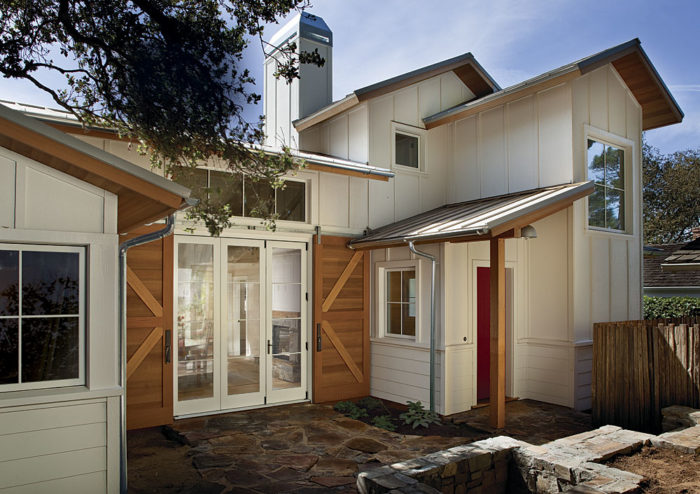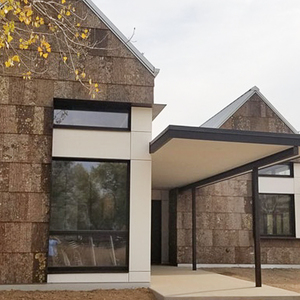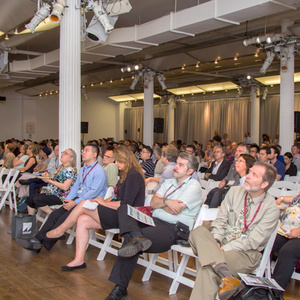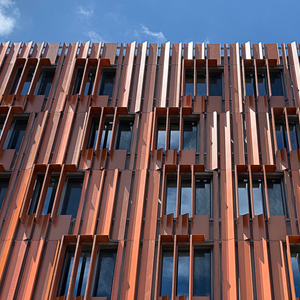
Image Credit: Rick Pharaoh
After both growing up in California, Mica and Laureen lived together in many other places throughout their busy careers. Their hearts have always been on the West Coast, though, and they longed to return one day. They eventually found a small piece of property in the coastal enclave of Carmel-by-the Sea on the Monterey Peninsula, and they hired me as architect and Rob Nicely of Carmel Building & Design as builder for a new house that will one day be their permanent home. The collaboration yielded a new type of house for this area, one that appropriately breaks free of the local vernacular while also meeting the country’s most aggressive performance benchmarks.
This Passive House is a first for Rob, for me, and for the city of Carmel. Working on this project has confirmed for Rob and me the importance of sustainable, high-performance design and building. For the city and for those who now get to experience this home, I hope the house evokes a realization that design and performance can be held to the same very high standard and that beautiful, exceptionally low-energy homes are within our collective reach.
A fear of Passive House
One of the initial challenges with our project was providing Mica and Laureen with the house that they wanted while also convincing Carmel’s strict planning commission that the project would complement the existing city fabric. When we first sent the project to the commission, we were so excited about the idea of building Carmel’s first Passive House that we included a Passive House brochure. Unfortunately, that decision had the opposite effect of what we hoped. Instead of getting people excited about our project, it scared them into thinking that we were going to build a box with a wall of south-facing glass and…
Weekly Newsletter
Get building science and energy efficiency advice, plus special offers, in your inbox.

This article is only available to GBA Prime Members
Sign up for a free trial and get instant access to this article as well as GBA’s complete library of premium articles and construction details.
Start Free TrialAlready a member? Log in















19 Comments
Oh Boy!
I'm not sure why to say. This is a very well designed and pleasant house that does a lot of things well - but $425 a square foot? That's three times what I typically build for.
Leaving that aside, there is a brief description of "phase-change materials". Anyone know more about them?
Yes, PCM what are they?
Malcolm,
I wondered the same thing about the cost and the phase-change materials. I guess part of the cost is because it's California.
Lucy
Yes it's hard to know what things should cost in other regions, but surely that's high for anywhere? GBA has published a couple of quite reasonably priced PH's recently, and I was just beginning to think the premium to build one wasn't that severe but...
PH costs...
C'mon folks...this is a small, well-appointed custom house in Carmel, CA. Being surprised at this cost per ft2 is like being surprised that a good hamburger costs $20 in Manhattan. The cost of the house has relatively little to do with the PH features...just as the cost of the burger has relatively little to do with the cost of the grass-bed beef. ;-)
John
Okay.
Fireplace?
Fireplace? Looks to be a gas unit, does it give off any heat? I'm under the impression that fireplaces usually allow more warm air to run up the chimney than they add to the house. Is there some feature of this fire place that allows it to significantly contribute heat to the house?
cost per square foot
There needs to be some sort of agreement on what is included in cost per square foot. Does it include design fees? Site preparation?
My PGH, now almost done, will end up well over $200 per square foot if I include the garage as part of the cost, but don't include it as square footage. With foot thick walls, do I delete the 200 square feet of slab covered by them, making the house 1650, rather than 1850 square feet? Include the $22K for a PV system. Subtract the $6600 tax credit?
Of course, decisions about what materials to use will move the cost numbers around, without any impact on energy use or meeting PH standards. I decided on a standing seam roof, but using asphalt shingles would have saved several dollars per square foot. We're putting in an expensive HRV. A couple of exhaust fans would have been cheaper.
Honker Gas Stove?
Two questions occur:
1) How do they manage make-up air for that gas stove?
2) How do you reconcile >20k BTU output from the stove with a house that demands much less than this on the coldest day of the year?
They seem to have navigated into unchartered territory here. I hope they will map out their route so some of us can follow. Personally, I had given up on any hope of having a gas stove in the "Pretty Good House" I am building, which will have less than a 2-ton heating load.
Seems to break all the rules...
I saw this home on the FHB site, and had many of the same questions expressed above. I am interested to see how the experts here weigh in on the huge stove & vent, fireplace, and complicated footprint (how many corners does this place have?).
Response to Jessica Doench
Jessica,
The main reason that this Passive House "seems to break all the rules" is that is is located on the California coast, not Chicago.
This house was built in a location that requires almost no heating and no cooling. In a climate like that, it's extremely easy to meet the Passivhaus standard.
If one can afford to live in
If one can afford to live in Carmel then the price per sq foot quoted would never be a problem. It is out of reach for most people in California, including yours truly. Martin, I repeatedly get the impression you are out of touch with weather here. We are not Hawaii. We actually go vacation there in winter to get out of the bad (relatively) winter weather here. Of course, that does not mean it even compares to where you live. I just mean that most people don't spend a lot of time outdoors in winter, or summer for that matter, in the hotter areas. It's just not comfortable then though its much better weather than 90% of the country. Basically the average temperature is good as opposed to elsewhere but the extremes are not comfortable. That would not be the case in places like Hawaii.
Response to Eric Habegger
Eric,
Weather data for Carmel, California:
Average maximum temperature, 77 degrees F
Average minimum temperature, 50 degrees F
Annual heating degree days, 2,556
Annual cooling degree days, 1,967
Percent of possible sunshine, 79%
Average number of days snow, 0
Average annual snowfall, 0 inches
Yes Martin, but you missed my
Yes Martin, but you missed my point entirely. You are repeating the mistake I just noted just of using just average temps and not noting deviations from the norm. Yes, our average temps are close to Hawaii but the deviations, both seasonally and even daily are far from it. It sure as hell does not feel like Hawaii in winter. But I guess you feel secure pronouncing how it is here from your perch in New England. It must be great to pronounce how others should feel about something without having any exposure at all to that person's experience. How pleasant for you.
Response to Eric Habegger
Eric,
I didn't pronounce how you feel. I just noted that Carmel has 2,556 heating degree days. In a climate with 2,556 heating degree days, it's relatively easy to meet the Passivhaus standard.
Response to Martin Holladay
I thought to myself after your comment "should I quibble?". Oh yes. You previously said that is "extremely easy" to meet the passive house standard in Carmel. Obviously tone is important in any conversation and your tone was that it is a gimme to get PH accreditation in California. Obviously from just looking at the construction details in this article it was not extremely easy to meet the PH standard for this house. I will grant you that it is "relatively easy" to meet it compared to Vermont. That is a true statement.
The reason I objected to your original statement in comment 10 was because it reinforced a common misperception (prejudice?) towards those living here that we all might be somehow deficient in character for us to not all have passive houses out here. This reinforces people's preexisting prejudices that we all pot smoking, gay, hippies out here. I know. I went to college in Indiana way back when and they actually thought that!
Phase change materials
A short article:
http://www.building4change.com/article.jsp?id=474#.VOLUCCm4n_g
Phase change materials
It would be interesting to know to what extent the pcm material contributes to the passivhaus performance calculations. The link supplied by Malcom Taylor suggests a temperature swing of 4* C (8* F) to have an effect. This is well outside the range maintained by an active HVAC system for generally acceptable comfort conditions.
Response to James Morgan
James,
I agree. My understanding of phase change materials is that they depend on occupants (and specially programmed thermostats) willing to accept wide daily indoor temperature swings.
Fine Home Building
While I'm enjoying the articles culled from FHB, the one weakness is that, unlike the ones commissioned directly by GBA, the people involved don't seem to be available to discuss or explain the projects.
Log in or become a member to post a comment.
Sign up Log in